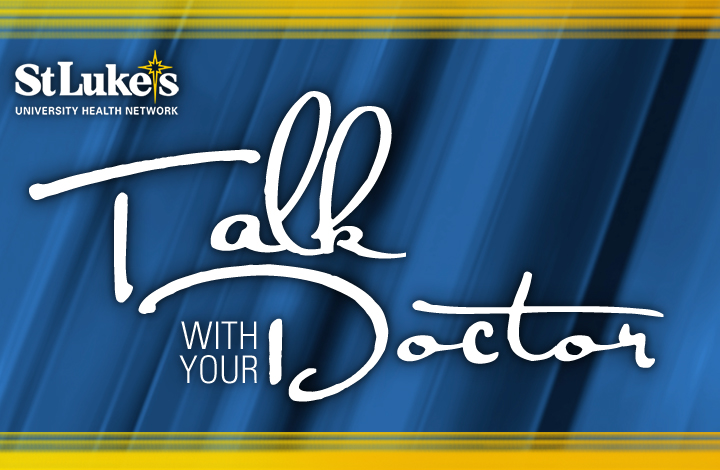Shoulder Replacement Surgery at St. Luke’s Puts Saucon High’s “Coach K” Back in the Game
April 25, 2024

Saucon Valley coach Ed Kolosky shows off the range of motion after undergoing shoulder replacement surgery with St. Luke’s Chief of Orthopedic Sports Medicine Gregory Carolan, MD., of St. Luke’s Orthopedic Care
Ed Kolosky, a.k.a “Coach K,” suffered agonizing pain and restricted movement in his left shoulder for some 20 years. Any time he played golf, coached his athletes at Saucon Valley High School, shot hoops or cruised along on his mountain bike, the Hellertown resident was reminded that his shoulder needed medical attention, that it wasn’t going to heal on its own.
At 66 years old, and still coaching track and field, swimming and cross-country, the coach wishes he had gotten surgery at St. Luke’s sooner than last November. He’s thankful to St. Luke’s Chief of Orthopedic Sports Medicine Gregory Carolan, MD., of St. Luke’s Orthopedic Care, who operated on him, vastly improving his personal and professional life.
“He did it perfectly,” said Coach K, “He’s the master of his craft.”
Coach K adds a robust shout-out to physical therapist, Jeff Hetrick, PT, MPT, at Physical Therapy at St. Luke’s—North, for his post-surgery rehab. At St. Luke’s, he had a team of champion caregivers that got him back in his game.
“Just a few months after the operation,” he adds, “I was doing things I couldn’t do comfortably in years and pain-free!”
On a week-long golfing trip with his buddies in March, Coach K was amazed by the transformation. Not only could he swing his clubs unimpeded and painlessly, but he’s now crushing his drives 70 yards further than ever.
“I whispered a prayer of thanks for Dr. Carolan and Jeff with each drive.”
Coach K’s problem began when his shoulder was jammed and dislocated by a friend’s elbow during a pickup basketball game back in 2004. Unrested, unrepaired and ignored for so long, the joint injury developed advanced osteoarthritis from the repetitive bone-on-bone friction.
“The injury started the degenerative process,” explained Dr. Carolan. “He gradually lost the cartilage in his shoulder, his ball and socket wearing it away and increasing deformity of the joint.”
“I was in constant pain, taking extra-strength Tylenol morning and afternoon,” added the Coach.
Why did he put off the surgical repair for so long?
“I was chicken,” admitted the lifelong jock. “I had heard about the horror of rehab after the surgery.”
He initially went to Dr. Carolan in hopes of finding a non-surgical solution.
“We tried conservative approaches to manage his symptoms: anti-inflammatories, cortisone shots and physical therapy over the years,” added Dr. Carolan. “They had limited effectiveness.”
“He told me, ‘Your shoulder is a freakin’ mess. You need to get it fixed.’”
The turning point came last fall when Coach K was chided by his granddaughters for throwing a softball underhand when they were playing catch.
“They said, ‘Pop-pop, you have to throw overhand,’” he recalls. “That was enough for me.” He suddenly had the courage to undergo the knife.
During the surgery, which took less than an hour, Dr. Carolan replaced Coach K’s ball and socket with a metal and plastic joint. He performed what is known as a “reverse” shoulder replacement, in which he attached the new socket to the end of his arm and connected the new ball to his shoulder bone, opposite of the conventional procedure. This technique provided the needed functionality to Coach’s joint, since his rotator cuff was damaged beyond repair.
Dr. Carolan performed the meticulous operation, one he’s done many times, guided by a 3D model of his patient’s shoulder, obtained from a CT scan of the ruined joint. The painstaking planning, using advanced imaging and navigation technology, resulted in a joint that will serve his patient well for the foreseeable future.
Dr. Carolan completes 100-150 shoulder replacements each year. He has performed these operations on people as young as 32 and as old as 98, though the average age of his shoulder replacement patients is 65-75 years.
After surgery, Coach K was astonished he didn’t need to take pain meds. The long-acting nerve block anesthesia administered in surgery controlled the pain for several days when it would have hurt the most.
“I wasn’t toughing it out,” he insisted, “I really didn’t have pain.”
“And PT helped the healing progress quickly.”
He started a nine-week physical therapy program less than a week after surgery, guided by Hetrick, who specializes in post-shoulder replacement rehab.
“Ed was a great patient who did everything I asked him to do and more,” Hetrick said. “We worked on restoring functionality and strength to his shoulder, and he continued these exercises at home. And for this, he got an ideal outcome.”
Coach K and his St. Luke’s team were amazed and pleased at how far he progressed so quickly.
“I soon was able to raise my arm above my head without pain or hesitation for the first time in decades,” he said.
His shoulder hasn’t felt this good in years. On the track, in the gym, on the pool deck and astride his bike, he sings the praises of his St. Luke’s ortho team.
“I want people to know the quality of care I received from St. Luke’s was top-notch,” he said. “I couldn’t be more pleased with my entire experience there.”
He offers this advice to anyone who finds themselves in a similar situation to him.
“Don’t put off surgery when you need it and suffer like I did for so long. Having the right people on my team made all the difference in the world.”
Read More News

